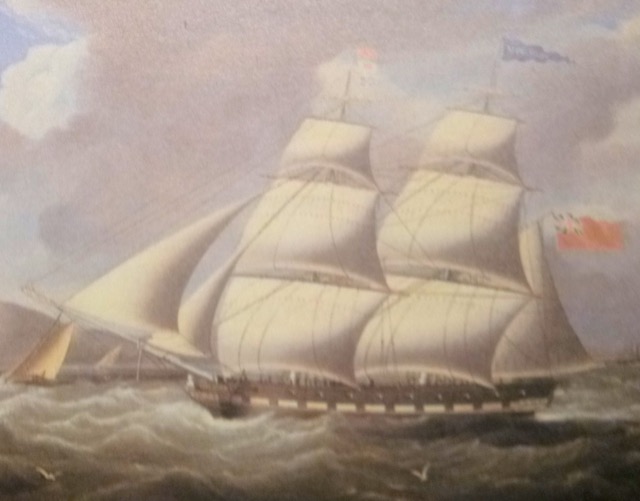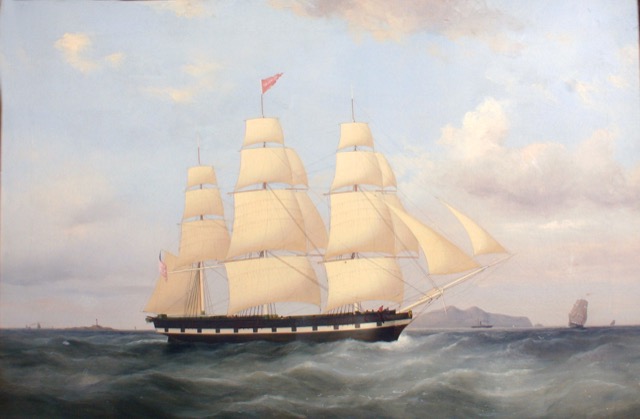
Mary Scott
Wooden brig built Liverpool 1828, owned Mrs Little, 248 tons
Sunk from collision with Brooklyn 10 May 1841
Approximate position: 53°27' N, 4°16' W; near Point Lynas.
Captain Sadler and 15 crew; lost 9.
Mary Scott: (painting by Miles Walters of Liverpool circa 1830)

Brooklyn. US registered.
Wooden full-rigged ship built Newcastle, Maine, 1834, 445 tons, 125 ft long
Brooklyn: (Painted off Holyhead by Duncan MacFarlane)

Dreadful collision in the Liverpool channel
Yesterday seven unfortunate mariners, as part of the crew of the brig Mary Scott, Capt. Sadler, inward bound from Valparaiso, were brought into the King's dock in this port (Liverpool), by a fishing boat, having been found, in a small boat without sails and only two oars, tossing about the channel in an exhausted state, without food or clothing, on Monday last, 12th of May, 1841, having been in that perilous situation with stormy weather and a heavy sea running, for 24 hours, their vessel (the Mary Scott) having been run down and sunk in consequence of one of those frightful collisions at sea which, as in the case of the Governor Fenner, has recently excited so much melancholy interest.
Captain Sadler and eight of his crew perished by the disaster, as the Mary Scott sunk in a few minutes after the collision occurred. The seven men brought into dock saved themselves by an immediate launching of the jolly-boat, into which the Captain might have leaped and saved his life but for his endeavours to save a box containing a large sum of money.
From the enquiries made relating to this shocking occurrence, it seems that between half-past 9 and 10 o'clock on the night of Sunday last, an emigrant ship, called the Brooklyn, Captain Richardson, bound for New York, when in view of the light at Point Lynas, suddenly ran down the Mary Scott, and it is supposed that the accident resulted from the recent alterations made at the Trinity House relating to the steering of ships.
At the time of the collision, the wind was from the land and the Mary Scott was closed hauled upon the starboard tack and just upon the point of altering her course, when the crew saw the ship Brooklyn coming down free, with her top gallant, sails set.
The Mary Scott had two lights on her weather bulwark, just abaft the main rigging; one of them being a regular signal light; the carpenter of the brig was steering and the mate told him to put the helm hard up, which was done.
The mate then got upon the bulwarks and called to the people in the Brooklyn. The people on board appeared to take no notice and the ship, which was going at a rate of about 7 knots an hour, in a few seconds after this struck the Mary Scott just where her lights were, upon the starboard side and stove her in.
After the unfortunate collision, the mariners of the brig who have survived, state that the Brooklyn passed on without offering any assistance. Capt. Sadler sustained serious injuries by the collision and ran about the vessel crying out that his back was broken. The right arm of the carpenter was also much injured and the mate was jammed between the round house and the bulwarks by the broken materials of the brig's starboard quarter.
After the lapse of about five minutes, the mate managed to extricate himself and found that the mainmast, the main-stay and the entire brig's rigging, had been carried away by the Brooklyn and that she had five feet of water in her hold. All hands were immediately on deck and endeavoured to get out the long boat, but she was so entangled with spars and cordage, that their efforts to do so were unsuccessful.
The Captain went below, and the mate seeing that the vessel was fast sinking, ran to him in the cabin, and told him that if he wanted to save himself, now was the time.
The Captain said in reply "well, take this box of specie and I will come." The mate took the box and ran upon deck, but seeing that the brig was sinking fast, he dropped the box and jumped into the jolly-boat, with the carpenter, four of the crew, and a boy, being seven in all.
The other men who were on deck had the same chance, but the mate is of opinion that they were bewildered with the terror arising from the awful situation in which they were placed. They, with the Captain, perished; and it turned out fortunate for those who got into the boat that no more joined them, or in all probability none would have survived to tell the tale, for she prove so leaky, that had there been a greater weight, she could not have lived.
They had no sooner dropped astern of the Mary Scott than the latter went down with the rest of the hands on board, their piteous cries being heart-rending in the extreme.
The wind, at the time, was very squally and there was a heavy sea. The mate had to break the case from the chronometer in order to bale the boat of the water to keep them from being swamped. They had on board neither food nor fresh water and from the confusion of leaving the ship, they were scantily clothed.
The mate was covered only by a cotton shirt, he having thrown off his clothes under the apprehension that he should have to swim for his life. In this state, the poor men drifted towards Holyhead and after towards the Isle of Man.
The weather continued very stormy during the next 24 hours, with continual rain, and they were subsequently picked up near the island by the Manx fishing boat already mentioned. The wrecked vessel was of 300 tons burden and was the property of a lady named Little, residing of Liverpool.
She had on board a valuable cargo of wool, copper ore, and $120,000 in specie. The vessel and cargo is said to be insured to the amount of £35,000.
The particulars above stated are chiefly gathered from the individuals saved from the wreck of the Mary Scott, from which it would appear that the Captain and crew of the American vessel treated the melancholy occurrence with great indifference. The Brooklyn has since put into Liverpool, having sustained great damage: with loss of bowsprit, cut-water, etc and leaky.
Her living cargo was emigrants to New York with 195 persons in total, from different parts of England. It appears from Capt. Richardson's statement that the night was pitch dark at the time and that the collision was wholly the result of untoward accident and he accounts for the statement that the Brooklyn passed on, by stating that he was afraid for his own vessel, with the intention of putting about to go to the assistance of the Mary Scott; he heard the shrieks of those on board of her and found that she had sunk.
He certainly had a great charge, having a large number of emigrants on board. The Brooklyn will not be fit for sea again for some time.
Salvage Dive 1850
[from General Commercial Advertiser - Tuesday 27 August 1850]:
About nine years ago, as the brig, Mary Scott, laden with copper ore
and a general cargo and having on board a large quantity of specie,
was returning from Valparaiso, she was ran into, about five miles east
of Point Lynas, by an American ship called the Brooklyn, and the
result was that the Mary Scott sank in deep water, and six or seven
persons on board perished. Some time afterwards the brig Parana,
outward bound for Montreal, was run down by the Iron Duke between
Ormeshead and Point Lynas [10 Sept 1844]. No traces of either vessel were
discoverable until about three weeks ago, when a Liverpool fisherman,
named Richard Price, whilst trolling near to Point Lynas, found that
his net had become entangled to something beneath the surface of the
water, and, on examination, discovered that it had caught in the wreck
of a vessel. It is not positively known what with which of the brigs
the net became entangled; but, it is supposed that it is the Mary
Scott. The Liverpool of Steam Tug Company have sent out a number of
divers to the place where the ship was discovered. But, in consequence
of the rough state of the weather, have not yet been able to commence
operations.